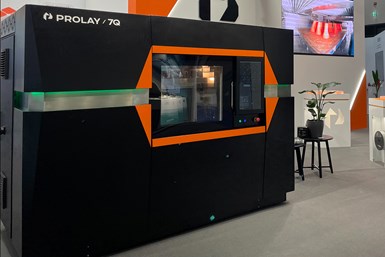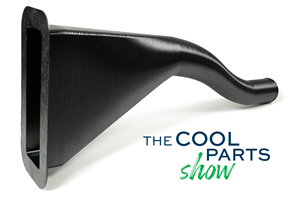Prolay 7Q 3D Offers PLTM Technology for Polymer, Composite Additive Manufacturing
The Prolay 7Q can produce components 1.5 to 5 times faster than conventional AM methods and produce parts with different layer thicknesses in a single process.
Prolay, a subsidiary of Bibus Menos, a Polish-Swiss company specializing in pneumatics, mechatronics, industrial automation and additive manufacturing (AM), has developed the Prolay 7Q industrial 3D printer.
The Prolay 7Q operates with the Progressive Layer Thickness Manufacturing (PLTM) technology, which is an advanced variant of the popular fused deposition modeling (FDM)/fused filament fabrication (FFF) method. This technology is known for its progressive layer thickness, which enables the printer to keep high-resolution surface finishes without sacrificing efficiency or durability.
Depending on the part geometry, the company says the Prolay 7Q can produce components 1.5 to 5 times faster than conventional AM methods. It can also produce parts with different layer thicknesses in a single process. The printer has a large build area of 725 × 450 × 500 mm, making it easy to produce large parts or multiple smaller ones at once.
The printer’s maximum chamber temperature reaches up to 190°C, which is crucial for processing high-temperature plastics. It features four printing heads with nozzle diameters ranging from 0.2 to 0.8 mm. The maximum temperature at which the extruder can operate is 400°C, ensuring compatibility with a wide range of commercial substances.
Layer heights range from 0.12 to 0.92 mm, giving users flexibility in balancing speed and finish quality. The Prolay system is compatible with various materials, including ABS, ABS-CF (carbon fiber-reinforced ABS), PC (polycarbonate), PC-CF (carbon fiber-reinforced polycarbonate) and PC-ABS (polycarbonate and ABS composite).
Prolay 7Q can mix up to three different materials in a single production process, which can be used to make strong composite configurations. This ability helps make thin layers of fiber-reinforced materials. For example, Prolay 7Q can print a PC shape at 0.1 layer thickness and then use carbon fiber filament inside.
Prolay is a brand of Bibus Menos, a Polish-Swiss company that started its business in Poland in 1994 as Menos. After several years, it became a part of the Bibus AG holding company, which is operating in more than 30 European and Asian countries. This strategic partnership enables the company to actively leverage over 60 years of experience and the multicultural expertise of the Bibus Group. Bibus Menos has been working in the field of 3D printing in Poland since 2005.
Prolay 7Q and PLTM technology are the results of research and development that started in 2017 as part of the project, “Development of a Faster 3D Printing Method to Reduce Production Costs and Improve Mechanical Properties while Keeping Optimum Quality.” This project was supported by the European Union through the European Regional Development Fund under the Intelligent Development Program 2014–2020.
Related Content
Drones Take Flight with Metal and Polymer 3D Printed Parts: The Cool Parts Show Bonus
Drones produced by Cobra Aero now incorporate many 3D printed parts made through laser powder bed fusion and Multi Jet Fusion processes.
Read MoreLarge-Format “Cold” 3D Printing With Polypropylene and Polyethylene
Israeli startup Largix has developed a production solution that can 3D print PP and PE without melting them. Its first test? Custom tanks for chemical storage.
Read MoreAircraft Ducts 3D Printed in Composite Instead of Metal: The Cool Parts Show #68
Eaton’s new reinforced PEKK, tailored to aircraft applications, provides a cheaper and faster way to make ducts compared to formed aluminum.
Read MoreThis Drone Bird with 3D Printed Parts Mimics a Peregrine Falcon: The Cool Parts Show #66
The Drone Bird Company has developed aircraft that mimic birds of prey to scare off problem birds. The drones feature 3D printed fuselages made by Parts on Demand from ALM materials.
Read MoreRead Next
To Improve Performance of Compression Molded Composites, Add 3D Printed Preforms
9T Labs' Additive Fusion Technology enables the manufacture of composite structures with as much or as little reinforcement as is necessary, using 3D printed continuous fiber preforms to add strength just where needed.
Read More3D Printing Brings Sustainability, Accessibility to Glass Manufacturing
Australian startup Maple Glass Printing has developed a process for extruding glass into artwork, lab implements and architectural elements. Along the way, the company has also found more efficient ways of recycling this material.
Read MoreLooking to Secure the Supply Chain for Castings? Don't Overlook 3D Printed Sand Cores and Molds
Concerns about casting lead times and costs have many OEMs looking to 3D print parts directly in metal. But don’t overlook the advantages of 3D printed sand cores and molds applied for conventional metal casting, says Humtown leader.
Read More









.png;maxWidth=300;quality=90)














